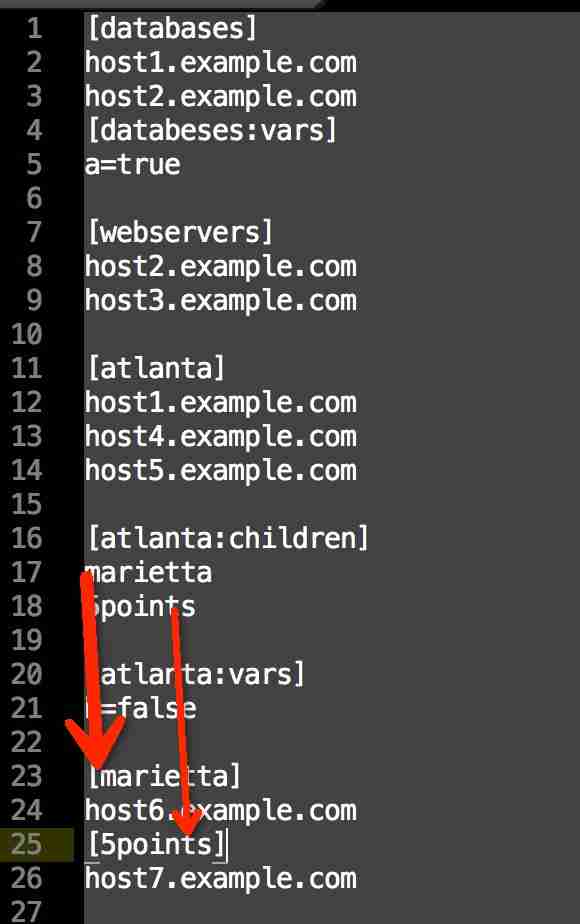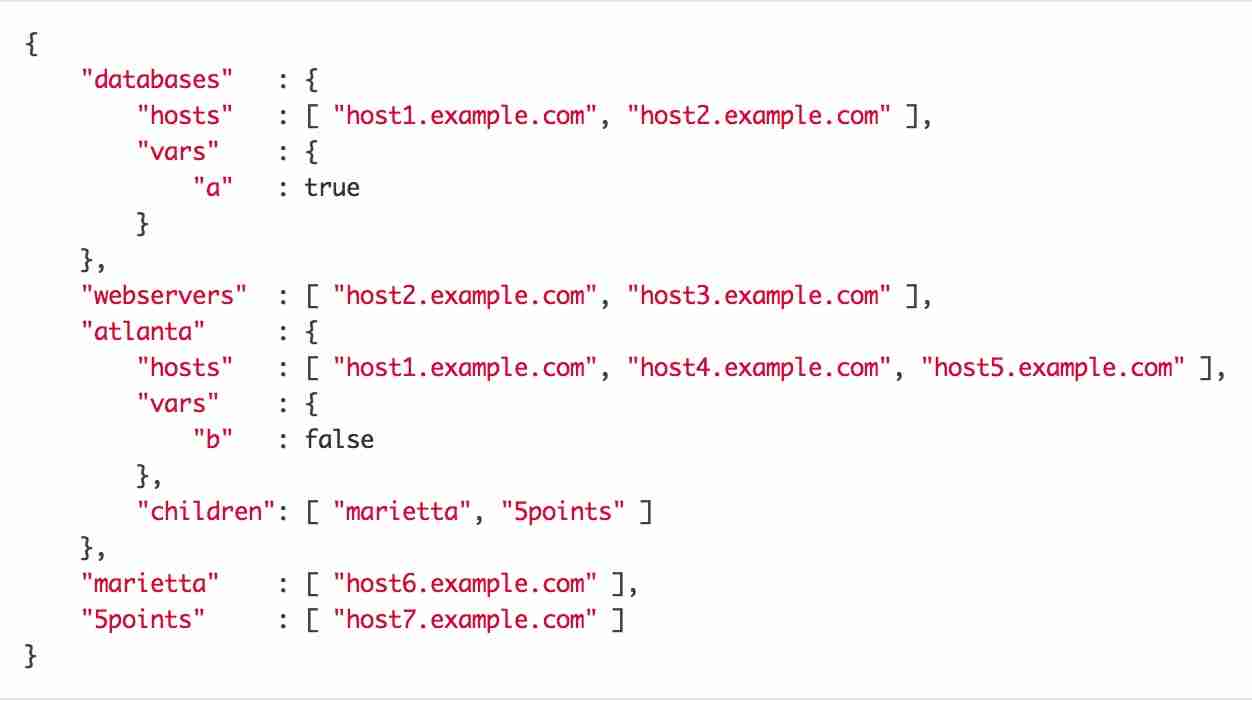Introduction to Ansible Dynamic Inventory
Ansible Inventory actually consists of two parts: static Inventory and dynamic Inventory. Static Inventory refers to the hosts and groups specified in the file /etc/ansible/hosts. Dynamic Inventory refers to obtaining the host list through external scripts and following the requirements of ansible The format returned to the ansilbe command. This part generally combines the CMDB asset management system, zabbix monitoring system, crobble installation system, cloud computing platform, etc. to obtain host information. Since host resources generally increase or decrease dynamically, these systems generally update intelligently. We can return the host list through the API or access library query provided by these tools.
Since Ansible supports json format when accepting scripts to dynamically obtain host information, I will not take it from other systems here, and print a segment of host information in json format through a piece of code:
#!/usr/bin/env python
# coding=utf-8
import json
host1ip = ['10.212.52.252','10.212.52.14']
host2ip = ['10.212.52.16']
group = 'test1'
group2 = 'test2'
hostdata = {group:{"hosts":host1ip},group2:{"hosts":host2ip}}
print json.dumps(hostdata,indent=4)Note:
1. The host part must be in list format;
2. In the hostdata line, the "hosts" part can be omitted, but if used, it must be "hosts" and cannot be other strings such as ‘‘hostlist’’.
After omitting, you can write it like this:
hostdata = {group:host1ip,group2:host2ip}The result of executing this code directly is as follows:
[root@361way.com ~]# python twogroup.py
{
"test1": {
"hosts": [
"10.212.52.252",
"10.212.52.14"
]
},
"test2": {
"hosts": [
"10.212.52.16"
]
}
}Two host groups are defined above. The test1 group contains hosts 10.212.52.252 and 10.212.52.14, and the test2 group contains host 10.212.52.16. ansible can be called through the following methods:
[root@361way.com ~]# ansible -i twogroup.py test1 -m command -a 'uptime' -k SSH password: 10.212.52.252 | success | rc=0 >> 23:01pm up 24 days 8:24, 2 users, load average: 0.21, 0.35, 0.39 10.212.52.14 | success | rc=0 >> 23:08pm up 332 days 5:23, 2 users, load average: 0.00, 0.01, 0.05 [root@361way.com ~]# ansible -i twogroup.py test2 -m command -a 'uptime' -k SSH password: 10.212.52.16 | success | rc=0 >> 23:09pm up 332 days 6:00, 2 users, load average: 0.08, 0.06, 0.05
In the static host configuration file example, there will be group variables (vars), including between groups, as shown below:

If you want the above part, get the implementation through the script. The json format returned after implementation should be as shown below:

Complex return formats like the above are generally not used in ad-hoc environments. Most of them are used in ansible-playbook. This is because the playbook file sometimes involves the passing of vars parameters.
This was mentioned at the beginning of this article. We obtained examples from platforms such as cobbler and cmdb. Since the initiator (author) of ansible is also the creator of cobbler software, the official document gives us an example of cobbler and an example of obtaining host information from AWS. As follows:
Get host information code on cobbler
Get host information code on aws cloud
Regarding how to obtain host information from AWS and put it into the database, I have written a related chapter before. For details, you can also refer to my previous blog post - AWS Host Asset Management (this article is also implemented in pure python).
Get host information through zabbix api. I also wrote a zabbix summary (8) Zabbix api. If you want to get host list information through zabbix platform, you can also refer to it.
1. The script called after the ansible -i parameter is not necessarily a py file, it can also be the output result of other scripts. Here is a simple test:
[root@361way.com yaml]# ansible -i group.sh test1 -m command -a 'uptime' -k
SSH password:
10.212.52.16 | success | rc=0 >>
00:18am up 332 days 7:10, 2 users, load average: 0.00, 0.01, 0.05
10.212.52.14 | success | rc=0 >>
00:17am up 332 days 6:32, 2 users, load average: 0.01, 0.03, 0.05
10.212.52.252 | success | rc=0 >>
00:11am up 24 days 9:33, 2 users, load average: 0.49, 0.42, 0.41
[root@localhost yaml]# cat group.sh
#!/bin/bash
groups='''
{
"test1": {
"hosts": [
"10.212.52.252",
"10.212.52.14",
"10.212.52.16"
]
}
}
'''
echo $groups2. The script specified by the -i parameter needs to have executable permission, otherwise an error will be reported, as follows:
[root@361way.com yaml]# ansible -i hostjson.py AA -a 'uptime' ERROR: The file hostjson.py looks like it should be an executable inventory script, but is not marked executable. Perhaps you want to correct this with `chmod +x hostjson.py`?
The above is the detailed content of Introduction to Ansible Dynamic Inventory. For more information, please follow other related articles on the PHP Chinese website!

Hot AI Tools

Undresser.AI Undress
AI-powered app for creating realistic nude photos

AI Clothes Remover
Online AI tool for removing clothes from photos.

Undress AI Tool
Undress images for free

Clothoff.io
AI clothes remover

AI Hentai Generator
Generate AI Hentai for free.

Hot Article

Hot Tools

Notepad++7.3.1
Easy-to-use and free code editor

SublimeText3 Chinese version
Chinese version, very easy to use

Zend Studio 13.0.1
Powerful PHP integrated development environment

Dreamweaver CS6
Visual web development tools

SublimeText3 Mac version
God-level code editing software (SublimeText3)

Hot Topics
 1377
1377
 52
52
 Unable to log in to mysql as root
Apr 08, 2025 pm 04:54 PM
Unable to log in to mysql as root
Apr 08, 2025 pm 04:54 PM
The main reasons why you cannot log in to MySQL as root are permission problems, configuration file errors, password inconsistent, socket file problems, or firewall interception. The solution includes: check whether the bind-address parameter in the configuration file is configured correctly. Check whether the root user permissions have been modified or deleted and reset. Verify that the password is accurate, including case and special characters. Check socket file permission settings and paths. Check that the firewall blocks connections to the MySQL server.
 C language conditional compilation: a detailed guide for beginners to practical applications
Apr 04, 2025 am 10:48 AM
C language conditional compilation: a detailed guide for beginners to practical applications
Apr 04, 2025 am 10:48 AM
C language conditional compilation is a mechanism for selectively compiling code blocks based on compile-time conditions. The introductory methods include: using #if and #else directives to select code blocks based on conditions. Commonly used conditional expressions include STDC, _WIN32 and linux. Practical case: Print different messages according to the operating system. Use different data types according to the number of digits of the system. Different header files are supported according to the compiler. Conditional compilation enhances the portability and flexibility of the code, making it adaptable to compiler, operating system, and CPU architecture changes.
 【Rust Self-study】Introduction
Apr 04, 2025 am 08:03 AM
【Rust Self-study】Introduction
Apr 04, 2025 am 08:03 AM
1.0.1 Preface This project (including code and comments) was recorded during my self-taught Rust. There may be inaccurate or unclear statements, please apologize. If you benefit from it, it's even better. 1.0.2 Why is RustRust reliable and efficient? Rust can replace C and C, with similar performance but higher security, and does not require frequent recompilation to check for errors like C and C. The main advantages include: memory security (preventing null pointers from dereferences, dangling pointers, and data contention). Thread-safe (make sure multi-threaded code is safe before execution). Avoid undefined behavior (e.g., array out of bounds, uninitialized variables, or access to freed memory). Rust provides modern language features such as generics
 How to solve mysql cannot be started
Apr 08, 2025 pm 02:21 PM
How to solve mysql cannot be started
Apr 08, 2025 pm 02:21 PM
There are many reasons why MySQL startup fails, and it can be diagnosed by checking the error log. Common causes include port conflicts (check port occupancy and modify configuration), permission issues (check service running user permissions), configuration file errors (check parameter settings), data directory corruption (restore data or rebuild table space), InnoDB table space issues (check ibdata1 files), plug-in loading failure (check error log). When solving problems, you should analyze them based on the error log, find the root cause of the problem, and develop the habit of backing up data regularly to prevent and solve problems.
 What are the 5 basic components of Linux?
Apr 06, 2025 am 12:05 AM
What are the 5 basic components of Linux?
Apr 06, 2025 am 12:05 AM
The five basic components of Linux are: 1. The kernel, managing hardware resources; 2. The system library, providing functions and services; 3. Shell, the interface for users to interact with the system; 4. The file system, storing and organizing data; 5. Applications, using system resources to implement functions.
 Can mysql run on android
Apr 08, 2025 pm 05:03 PM
Can mysql run on android
Apr 08, 2025 pm 05:03 PM
MySQL cannot run directly on Android, but it can be implemented indirectly by using the following methods: using the lightweight database SQLite, which is built on the Android system, does not require a separate server, and has a small resource usage, which is very suitable for mobile device applications. Remotely connect to the MySQL server and connect to the MySQL database on the remote server through the network for data reading and writing, but there are disadvantages such as strong network dependencies, security issues and server costs.
 Where is the C language function library? How to add the C language function library?
Apr 03, 2025 pm 11:39 PM
Where is the C language function library? How to add the C language function library?
Apr 03, 2025 pm 11:39 PM
The C language function library is a toolbox containing various functions, which are organized in different library files. Adding a library requires specifying it through the compiler's command line options, for example, the GCC compiler uses the -l option followed by the abbreviation of the library name. If the library file is not under the default search path, you need to use the -L option to specify the library file path. Library can be divided into static libraries and dynamic libraries. Static libraries are directly linked to the program at compile time, while dynamic libraries are loaded at runtime.
 Solutions to the errors reported by MySQL on a specific system version
Apr 08, 2025 am 11:54 AM
Solutions to the errors reported by MySQL on a specific system version
Apr 08, 2025 am 11:54 AM
The solution to MySQL installation error is: 1. Carefully check the system environment to ensure that the MySQL dependency library requirements are met. Different operating systems and version requirements are different; 2. Carefully read the error message and take corresponding measures according to prompts (such as missing library files or insufficient permissions), such as installing dependencies or using sudo commands; 3. If necessary, try to install the source code and carefully check the compilation log, but this requires a certain amount of Linux knowledge and experience. The key to ultimately solving the problem is to carefully check the system environment and error information, and refer to the official documents.




